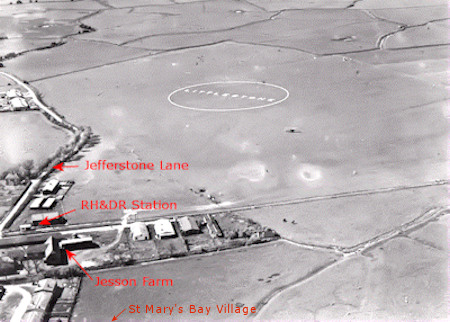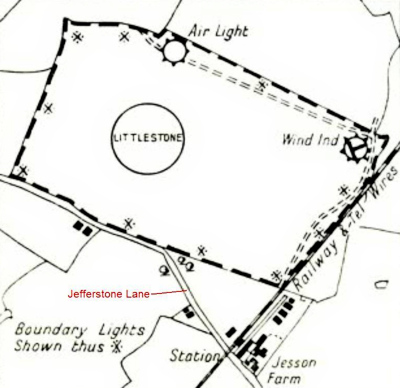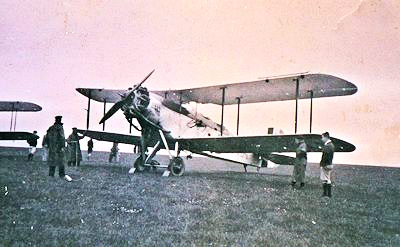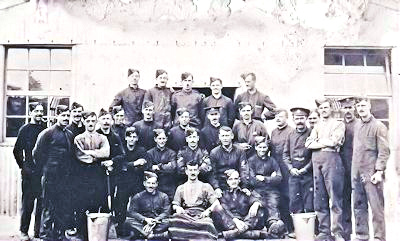Airfield at St Mary's Bay
The airfield at St Mary's Bay, now long gone, has been known under the names of Littlestone Airfield, Jesson Airfield and St Mary's Bay.
The development of the airfield did not begin in earnest until the 1914-1918 War when the War Department built a camp. Initially they used the landing strip on Romney Warren and part of the Littlestone Golf Course but soon moved to a proper aerodrome in Jesson Lane.This occupied 75 acres of land bounded by Jesson Lane and the Jefferstone and Cobsden Sewers.
The airfield was to house the Royal Flying Corps No.1 (Auxiliary) School of Gunnery amalgamated with No.1 (Observers) School of Aerial Gunnery. The camp was intended to accommodate 1000 men, 300 NCOs, 400 officers and 400 women. It was estimated that from each intake 400 trained pilots would receive their wings.
Location of the airfiled just north east of the RH&DR.
The chalk cricle identified the airfield and provided an aid to direction.
At the time this photo was taken (c 1930) what is now
Jefferstone Lane was called Jesson Lane

The Airfield
The Airfield was erected as transport garages to house lorries during the 1st World War. The main building ran parallel with the A259 road at the top of Jesson Lane (now known as Jefferstone Lane). A local builder acquired the buildings after 1st World War and converted both ends into living accommodation.
When in 1925 the Romney Hythe and Dymchurch Railway (RH&DR) was laid it cut across the top of the aerodrome leaving a rectangular flying field.
Administration and living quarters were located on the western side of Jesson Lane close to where it meets the main coast road. The field on the Dymchurch side was used to build sheds for transport and engineering. The main transport garages were close to the main road and were used for servicing large lorries and planes.
In later years the end of the building facing into Jesson Lane was converted to a shop and became Jesson Post Office.Further down the lane on the eastern side was the carpenters’ shop. With most of the aircraft being build with wooden frames and carpenters’ skills were much in demand. Tears and holes in the aircrafts’ linen-covered fuselages and wings were repaired in the adjacent sailmakers’ shop. In the adjoining dope shop shellac was applied to stiffen up and waterproof the linen, giving it great strength. The planes were then ready to return to service.

Plan of the airfield
While the Flying Corps were at here Jesson Farm was used as offices and the large barn as a cinema and theatre complete with stage. The highlight of passing out was a party and concert held in the barn.
Near the flying field and where the RH&DR line now runs stand four long brick-built sheds. Two of them were used for photographic laboratories and dark rooms. All the film taken by the air crews of the mock dog fights, aerial gunnery and target practice were processed there. Edith Nesbit, the author owned two sheds that were later turned into bungalows. In fact she lived there for some two years and most of the time was in ill health. Her husband Captain Tucker named the bungalows Longboat and Jollyboat. Both still stand today and can be seen at the bottom of Nesbit Road.
The last building belonging to the Flying Corps’ camp was the power station on the right of Jesson Lane just past the RH&DR station. This brick building housed two large single cylinder paraffin engines with enormous flywheels. The engines were started by using blowlamps and would generate enough electricity to meet the demands of the camp as well as some of the properties nearby.
After the 1st World War the engineer in charge was Mr. Charles Colmer who later started his own electrical business and used one room at the end of this bungalow as a shop. The shop today is Foord Electrical Centre. The Guardroom was at the top of Jefferstone Lane in the corner on the left opposite the transport garages. All the camp accommodation was on this side of the road. The first building block was the officers’ mess and dining hall.
A third group of buildings were the airmen’s billets, cookhouse and a hospital. After the war Lt. Chapman was left in charge of the camp with a care and maintenance party. He lived in and later purchased the hospital. He built a plane out of parts that had been left by the Flying Corps and flew it regularly.
The last building near the railway line was the mortuary. With a lot of student pilots flying and practising combat manoeuvres and dog fights, casualties must have been quite high. When the airforce left the aerodrome became a holiday camp and the mortuary was used as a meat store.

Oxford University Squadron Jesson Aerodrome 1930s
After the armistice in 1919, when the School for Aerial Gunnery was moved to Manston, the flying field was kept open to provide emergency landing facilities for the newly-established civil air services flying from Croydon to Paris and Brussels.
Although Lympne was the south coast customs airport it was particularly susceptible to fog. On occasions when fog enveloped Lympne planes were diverted to Littlestone (Jesson). The airfield was known as the Littlestone Emergency Landing Ground probably because the first airstrip was on part of the Littlestone golf links.
In the centre of the field was a large white circle made from blocks of whitewashed chalk. (see picture above) The name Littlestone was painted across the centre of the circle. Set at intervals around the circumference were tallish beacons, which at night constantly blinked and showed a red light. They were operated by gas and serviced by the round crews from Lympne. When planes landed taxis would arrive to collect the passengers and their luggage and take them on to their destinations or another airfield.
During the late twenties and the thirties the field was the venue of some spectacular air displays. One famous airman was Sir Alan Cobham with his flying circus. His team performed wing walking, parachuting and dare devil low flying. (Website Icon more information). On some weekends in the summer it was possible for the public to take pleasure flights.

Royal Flying Corps Personnel at Jesson Aerodrome
As air travel became more reliable with larger aircraft being used demand for the emergency landing facilities and Littlestone diminished. Just before the Second World War the landing lights were switched off for the last time and removed. The land reverted back to farmland and has remained so to this day. The old Jesson Aerodrome, situated near the edge of the flying field used to operate pleasure flights between the 1st and 2nd World Wars.


















